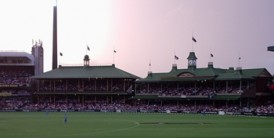The 1994/95 Ashes: A Pivotal Series for Australian Cricket
Marco Trevisiol |
Looking back on it 15 years later, Australia’s 3-1 Ashes victory over England in 1994/95 appears fairly insignificant compared with its more memorable Test series victories of the 1990s. It was just one in the middle of a sequence of comfortable Ashes victories they achieved in the 1989-2002/03 period against an often weak and inept opponent. If Australian cricket fans have any memories that stand out from that series today, they might be Michael Slater hitting the first ball of the series for four in Brisbane or Shane Warne’s hat-trick in Melbourne. Certainly there wouldn’t be any memories of it being a memorable contest.
But a close examination of this series shows that it was highly pivotal and significant for Australia in the context of their performances as a Test side in the 1990s.
Leading into this series Australia had stagnated and underachieved as a Test side for a couple of years. The beginning of this stagnation was in 1992/93 when they attempted to acquire the Holy Grail in cricket – winning the Sir Frank Worrell Trophy and being the first side to defeat the West Indies in a Test series for well over a decade. It was a series they dominated for long periods and should have won. Just after lunch on the final day of the first Test in Brisbane they had the West Indies on the ropes at 4/9 but the tourists managed to grimly hang on for a draw with two wickets in hand. Notably in selection Australia went with the conservative option of all-rounder Greg Matthews as the spinner instead of giving the young, raw but very talented Warne the role, who would then prove to be the match-winner in the following match in Melbourne.
The fourth Test in Adelaide is rightly remembered as one of the great modern Tests as Australia fell agonisingly short of winning it and the series, losing by a solitary run. With both sides going in opposite directions mentally, it was not surprising in the final Test on the pacy Perth pitch that the West Indies ran all over the top of Australia, winning by an innings before lunch on the third day.
But while the Adelaide Test is seen as the pivotal moment in the series, perhaps it was the third Test in Sydney that revealed Australia’s weaknesses. Batting first, fresh from a convincing victory and on a slow spin-friendly pitch ill-suited to the opponent’s pace attack (part-timers Carl Hooper and Jimmy Adams did the spinning duties) Australia scored 9/503 in 171.4 overs at less than 3 runs an over. It ensured Australia safety from defeat, but such a sluggish effort taking virtually two days also reduced Australia’s chances of victory. Indeed it was the opponents who provided the greater flair with the bat, with Brian Lara making his mark on world cricket with a dazzling 277.
Following on from this series, Australia’s results over the next 15 months were disappointing. While they notched up easy victories against weak England (away) and New Zealand (home) sides they were only able to draw series home and away against South Africa. The lowlight in these South African series was their loss in Sydney; despite dominating the match for virtually four days Australia froze chasing a very modest 117 to win the game, losing the match by 5 runs. Notwithstanding that it was a very slow scoring match, to fail to reach the target despite batting 56.3 overs (and South Africa having no quality spinner to exploit the spin-friendly conditions as Warne had done) was symbolic of Australia’s defensive mindset in pressure situations.
Probably their greatest underachievement in this period was only managing to draw an away series against a New Zealand side already in clear decline in early 1993, despite Warne totally befuddling the New Zealand batsmen in what was the first dominant series of his great career.
This was an Australian side full of talented and skilful players; apart from the experience of the then highest ever Test run scorer in Allan Border; they had the Waugh brothers Mark and Stephen; the brilliance of new star leg-spinner Warne; the high-class reliability of wicketkeeper-batsman Ian Healy; the pace and swing of Craig McDermott to lead the attack; and a very good opening batting combination of Mark Taylor and Slater. Today, many of these players are considered amongst Australia’s greats, so why were they not winning series consistently’
A likely major reason was that Allan Border lasted too long as captain. After the painful loss in 1992/93 to the West Indies his time was up. He had filled an enormous role when he took over as captain during the dark days of Australian cricket in the mid-1980s, when he had helped develop a team culture of fight and character after years of meek capitulations.
But he had been a captain for a certain period and a certain type of team and by 1992/93 the requirements of the team had changed. Australia needed to be led with assertiveness and aggressiveness to best utilise the latent talent in the side to compliment the stubbornness and fight they already had. These were leadership aspects that were not part of Border’s makeup against quality opposition and the results reflected this.
Border retired after the 1993/94 South Africa tour and Taylor was installed as captain. His captaincy at state and one-day international level suggested he was just what Australia needed; an attacking captain who would give full reign to the abundant talent in the Australian line-up.
Taylor’s first series as captain was in Pakistan in late 1994 and while they lost the series 1-0, there were many promising signs for the Australian side in that series. But for a missed stumping chance by Ian Healy, Australia would have won the thrilling opening Test in Karachi instead of losing it by one wicket. They made all the running in the second Test in Rawalpindi, forcing Pakistan to follow-on with only an epic double-century from Saleem Malik saving the match for the hosts. Perhaps most significant was the pace at which Australia scored its runs; in conditions traditionally not suited to them and against quality bowlers like Wasim Akram, Waqar Younis and Mushtaq Ahmed, for all of its innings of substance Australia’s run rate ranged from 2.97 to 3.81. These were run rates very rarely seen in the Border era and were symbolic of a more aggressive attitude to playing Test cricket.
But for all the promising signs, the Pakistan series had ended in defeat and this made the 1994/95 Ashes contest all the more important for Australia and Taylor. A drawn or lost series here and people would wonder whether the side was heading in the right direction. As well following this series they had the clearly tougher challenge of trying to be the first side to defeat the West Indies on their home turf for 22 years. It was reasonable to assume that if they could not beat England at home they were no realistic chance of winning in the Caribbean.
As well, England in the leadup threatened to be a more difficult opponent than they had been in previous Ashes contests. Their 1994 home form had been solid; victory against New Zealand followed by a drawn series against South Africa.
There was much expectation leading into the series, but in virtually all the key moments Australia came out on top. Symbolic of the dominance and assertiveness Australia had in this series was Slater cutting the first ball of the series at Brisbane from Phil DeFreitas to the boundary. It highlighted not only how the series would pan out (and how Slater would play during his career) but how Australia would play under Taylor; a highly talented side being allowed to play to their natural instincts by an aggressive and risk-taking captain, who almost always won the crunch moments in series.
Taylor showed his ability to go against conventional captaincy tactics at Brisbane. He declined to enforce the follow-on when all logic suggested that England were there for the taking. But he realised that his greatest bowling match-winner was Warne, and that he would be at his best on a wearing fifth day pitch. There were doubts whether Taylor’s strategy would pay off as first Australia’s second innings batting lost its way, then England put up a valiant rearguard action on the fourth day. With a day remaining Australia still needed eight wickets ‘ would Taylor face mass derision for throwing away an almost certain victory with a gross tactical miscalculation’
But as it turned out, his instincts were proven correct. England wilted under the strain of needing to bat more than five sessions to save the match as Warne weaved his magic, taking eight wickets in the innings and ensuring an Australian victory with plenty of time to spare. It was an important moment for Taylor, as he had not only obtained his first victory as captain but had done so in his own particular way, thereby validating his captaincy to cricket fans and probably to himself and his side.
Australia won in Brisbane by a hefty 184 runs but that was trumped by their victory in Melbourne by 295 runs, despite England having the better of the opening day. It was a victory that was rather atypical of the Taylor era (and more representative of the Border era) in the attritional way it was obtained (although England’s second innings collapse was swift). This was best represented by the fact that David Boon was Australia’s century scorer for the game, taking over six hours to score 138. Boon had been Australia’s premier batsman of the early 1990s but this series would see the beginning of his decline. This was his only score above 50 in the entire series and he would only score one more Test century (an even more sluggish effort in the following year’s Melbourne Test) before his retirement at the end of the 1995/96 season.
The third Test in Sydney proved a much harder challenge for Australia; they narrowly avoided following on and required a significant amount of inclement weather to save the game. Despite the ordinary performance, there were signs that even in adversity this was an Australian side with a different mindset. England had made all the running and set Australia a massive 449 to win in just over four sessions. Back then, the convention for a batting side in this situation was to be as defensive as possible and just try to bat out time.
Instead, Slater and Taylor on the fourth afternoon counterattacked so effectively that they had reached 0/139 by stumps. This led to the belief that Australia could pull off a miraculous victory and a very large final day crowd turned up to see it. It never eventuated but it was a forerunner to how batting sides would handle such challenges in future years, as for example when South Africa chased down a massive target in Perth against Australia last year.
The Sydney Test was also significant as after it Michael Bevan was dropped from the side, and his Test career never really recovered. Up until this series, all signs were that he would be one of the dominant players of Test cricket for years to come. He had been an outstanding player domestically and in his debut series in Pakistan, he had been highly impressive in scoring several half-centuries.
But for whatever reason, he had a horrid time in this series, failing to reach 40 in 6 innings before being dropped by the fourth Test. The defining dismissal for him was in Melbourne when he made a mess of a short ball from Darren Gough. From that point for the rest of his career he had the label of being vulnerable against short-pitched bowling and this perception (which would be backed up by further examples in later years) undoubtedly played a major part in severely curtailing his Test career. For the sake of his future Test prospects he would have been better off going out to a standard nick to the slips/keeper – which is in fact how he was dismissed most of the time this series.
The fourth Test in Adelaide exposed what was to be Australia’s greatest weakness under Taylor; losing ‘dead rubber’ matches when the series was over or in this particular case, when the Ashes were won. In theory it should have been Australia’s easiest assignment of the series, facing an opponent so depleted that they had only eleven fit players and wicket-keeper Steve Rhodes (who failed to score a fifty throughout the series) had to bat at six. But despite Australia being in a dominant position after three days, England managed to fight back for one of their more memorable wins of the 1990s.
Australia’s sloppy effort in Adelaide meant that there was quite a bit on the line for Taylor’s side going into the final Test in Perth. If they let England draw the series in light of how much Australia had dominated the first two Tests, the old issue of drawing/losing series they should win comfortably would have continued to be a significant cloud hovering over the side. But on this occasion Australia delivered the goods; on top throughout the contest with aggressive, attacking play that eventually saw their opponents collapse in their final innings for 125 and a 329 run defeat.
A key player in Australia’s performance this Test was paceman Glenn McGrath, and it was a turning point in his career. An intermittent member of the Test side over the previous 12 months, he took a big step backwards in the opening Test of this series in Brisbane. He went wicketless as his attempts to pitch it further up from his usual length and be a swing bowler failed dismally.
It looked as if he may have been out of the Test frame for some time but instead he managed to get back in for the final Test in Perth and was a completely different bowler. Reverting back to pitching the ball back to his traditional shorter length and using seam and bounce, he troubled the English batsmen throughout and took multiple wickets in both innings. He never looked back from this match and for the next twelve years adopted this strategy in all forms of international cricket with great success.
Australia’s performance in this 1994/95 Ashes series set the foundations for a highly successful period under Taylor when they went from being a talented but underachieving line-up to the undisputed best side in the world by the time of Taylor’s retirement in early 1999. The Ashes victory was the beginning of nine consecutive Test series victories for Australia (discounting the one-off Test played against India in 1996). The most famous of these was when they became the first side in 22 years to beat the West Indies on their own turf.
Throughout this period the amount of draws Australia would play out would severely decrease compared with the previous era under Border as they were prepared to risk defeat to chase victory. They were found out minus McGrath in India in 1997/98 and too often they would carelessly lose ‘dead rubbers’. But overall under Taylor Australia became the most talented and mentally toughest Test side in the world and the 1994/95 Ashes victory was a pivotal moment in this era.





My uncle played in this for England and played very badly. He scored one run so Aussie Aussie oi oi oi.
Comment by sarah mccague | 12:00am BST 18 July 2009